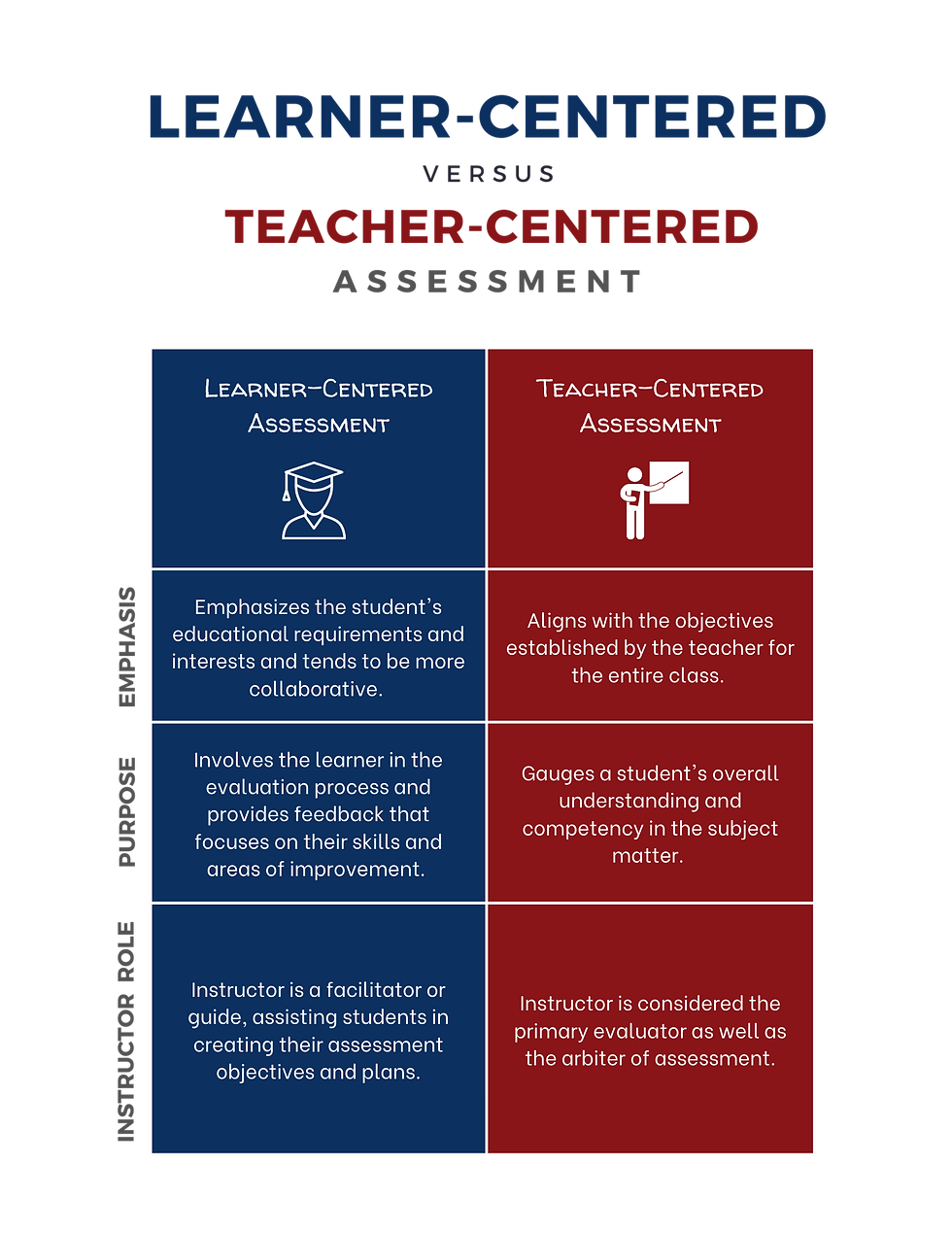Learner-Centered Assessment (Data)
- Dr. Patrick E. Crawford

- Apr 24, 2023
- 3 min read
Leadership Thoughts | Issue #110

As educators, we must find new ways to reach our students to ensure they are learning. When I began teaching, I followed a traditional instruction pattern: Unit one is taught, students take an in-class exam; then, unit two is introduced, and another in-class exam follows. A quiz each week, and everything goes into the grade book. It seems like many instructors teach the same way. I have learned that this kind of assessment does not challenge learners well. Instead, learner-centered assessments offer more effective results.
My current reflections on the difference between learner-centered and teacher-centered assessments inspire the content in this issue of Leadership Thoughts, in which I encourage the use of learner-centered assessment strategies. In general, learner-centered assessment is tailored to each student's needs and focuses on the individual, while teacher-centered assessment emphasizes more uniform evaluation centered around the educator. Both strategies present their pros and cons, so which one is used will depend upon the particular objectives of both the students and the instructor.

Benefits of Learner-Centered Assessment
Daniel Resnick and Lauren Resnick (1985) have said that American students are the most tested and the least examined globally. We have test scores coming out of our ears, but we do not yet do an excellent job of using assessment information to adapt curricula and instruction. A student-centered assessment provides valuable information for stakeholders at all levels— including students, teachers, administrators, parents, districts, and states—that can use to support learning. One crucial learner-centered assessment benefit that Resnick didn't mention is student motivation. Research has shown setting learning targets and monitoring the learner is highly motivational.
Examining and evaluating student learning is a huge part of setting up an environment focused on learning. But what I mean by assessment isn't tests and grades. These words (and others like data-driven instruction) have been hijacked to mean more testing and only knowing students based on their test scores.
Test scores can help us understand our students but should not be seen as the only indicator of their abilities and needs. Assessment allows us to learn more about the whole child, providing a better foundation for creating learner-centered classrooms. By viewing each student as a unique puzzle with many pieces, we create an environment tailored to each individual.
Goal of Learner-Centered Assessment
Learner-Centered assessment is about discovering what a learner can know, do, and be. The ultimate goal is to provide feedback that helps learners progress toward their learning objectives while allowing teachers to modify instructional practices. This type of assessment must be valid, reliable, practical, and efficient given the context in which it is used.
Learning-Centered assessments center around the learner, providing tailored feedback to help them grow. These assessments involve active engagement from the learner and keep them motivated. They also offer detailed task-specific feedback and are informative for all stakeholders involved in the learning process.
Learning and feedback are interrelated, with students being assessed by a few sources, such as themselves, their peers, teachers, and other external specialists. Learning-centered assessment is meant to support student learning while they are learning, not just measure how well they have known after the knowledge has been acquired. If learners are given regular feedback, they can develop during the course.
I'm fortunate enough to collaborate with an exceptionally gifted team on creating a set of micro-courses for Mass Customization. Chris Davis, Jessica Enderson, Charles Schwahn, and I are constructing three courses based on the topic: What Story Does Your Data Tell? The modules form part of the range of micro-courses available on JoltEDU through Appalachia Intermediate Unit 8. So, if you're after something unique regarding professional development, I suggest visiting the JoltEDU website, where you'll find various bite-size courses for educators on various subjects.
Subscribe to receive our "Leadership Thoughts" weekly!
Explore Our PIL Courses!
PLDC offers Pennsylvania Department of Education PIL-Approved Programs that count toward Act 45 continuing education credits.

Our programs are designed using the most current and proven methods for effective adult learning that keep participants engaged and promote knowledge retention. In addition to our core programs, we can work with you to create a completely customized program to meet your organization’s unique objectives.
CONTACT US TO JOIN TODAY!





Comments